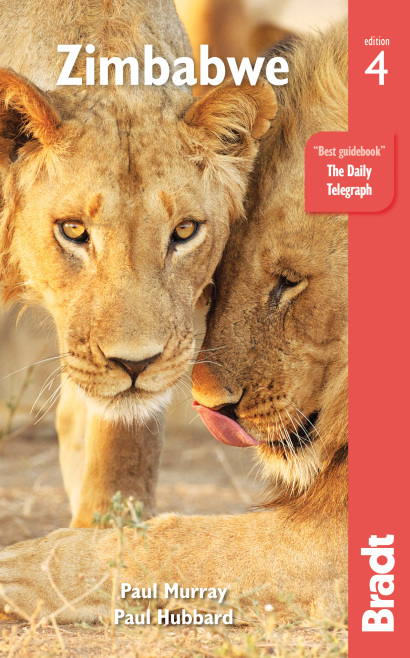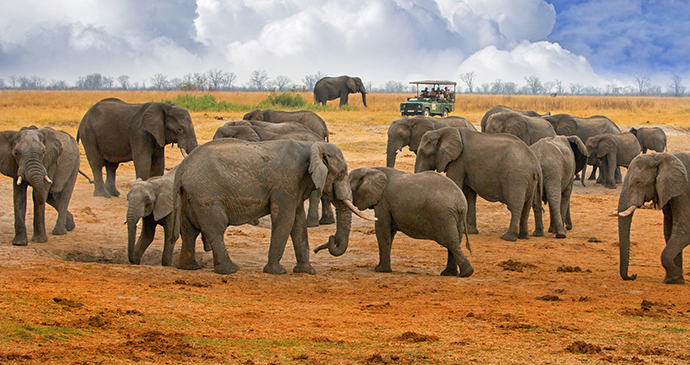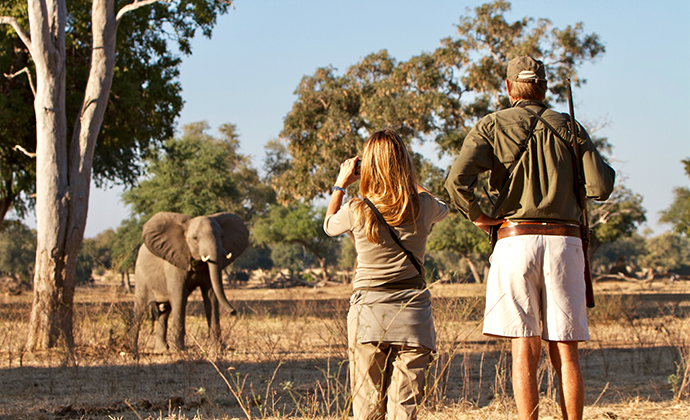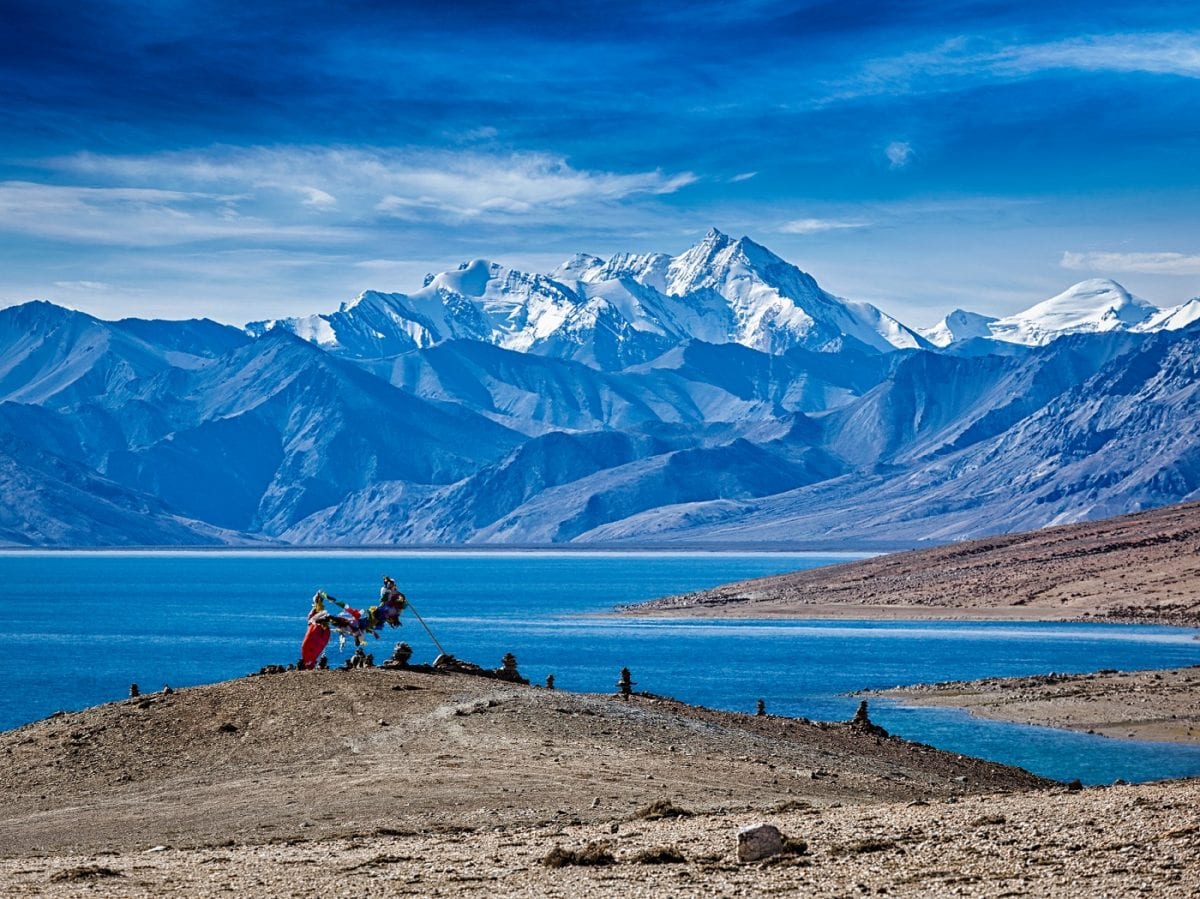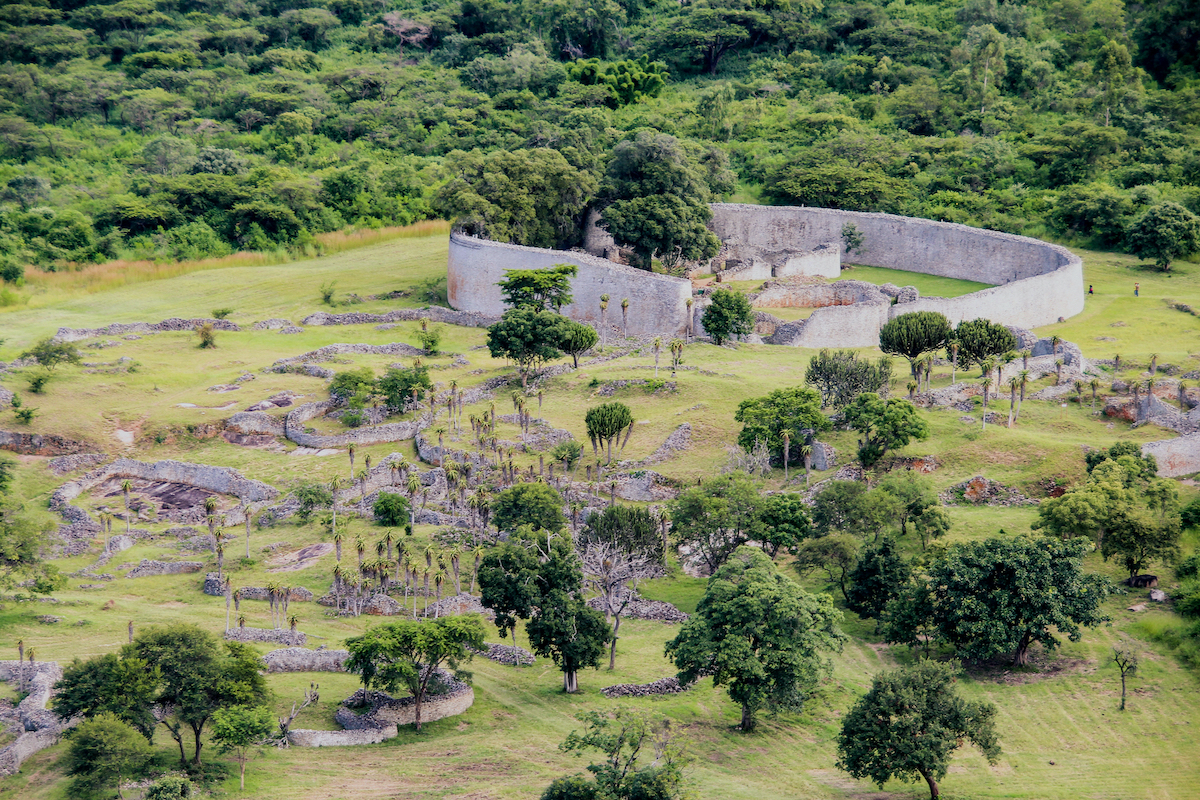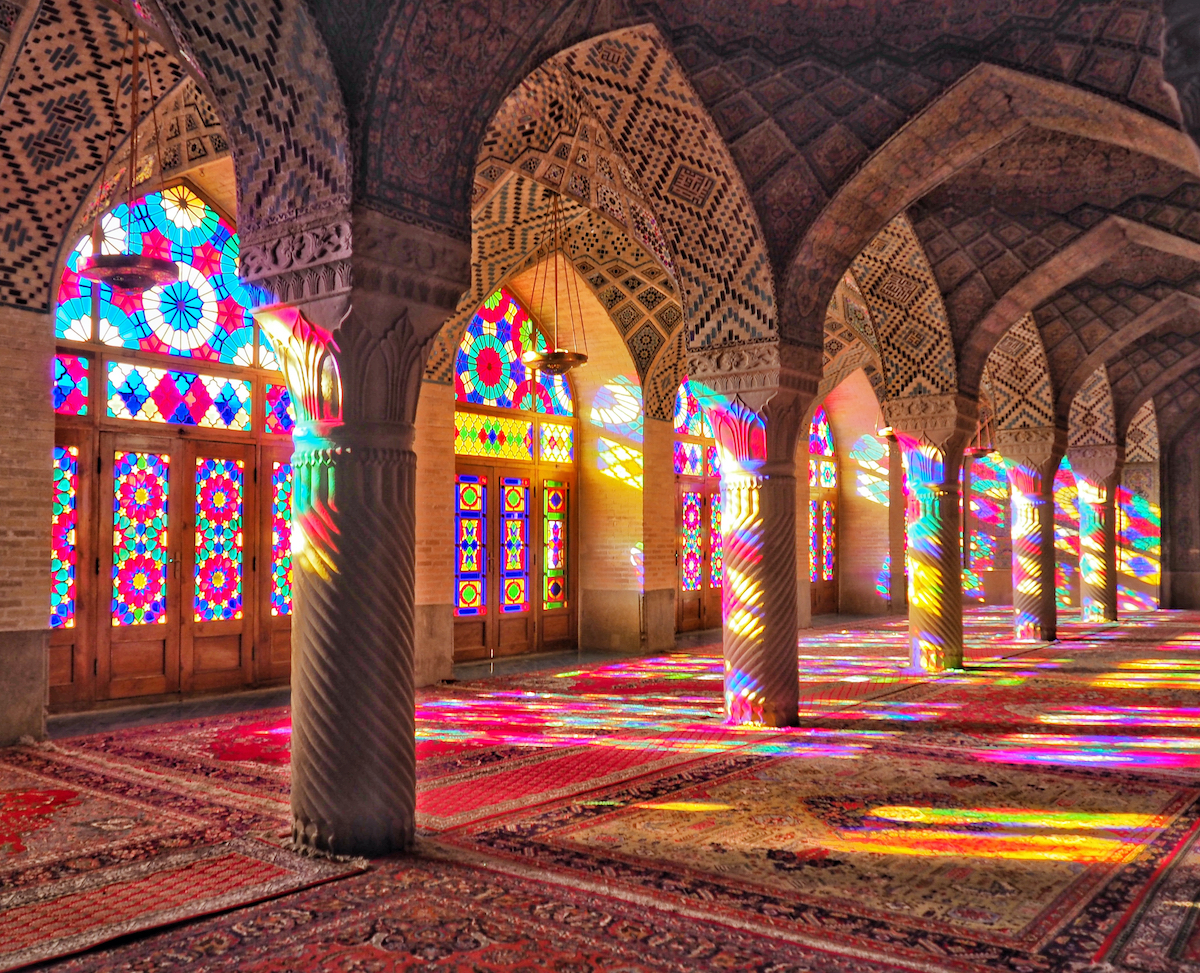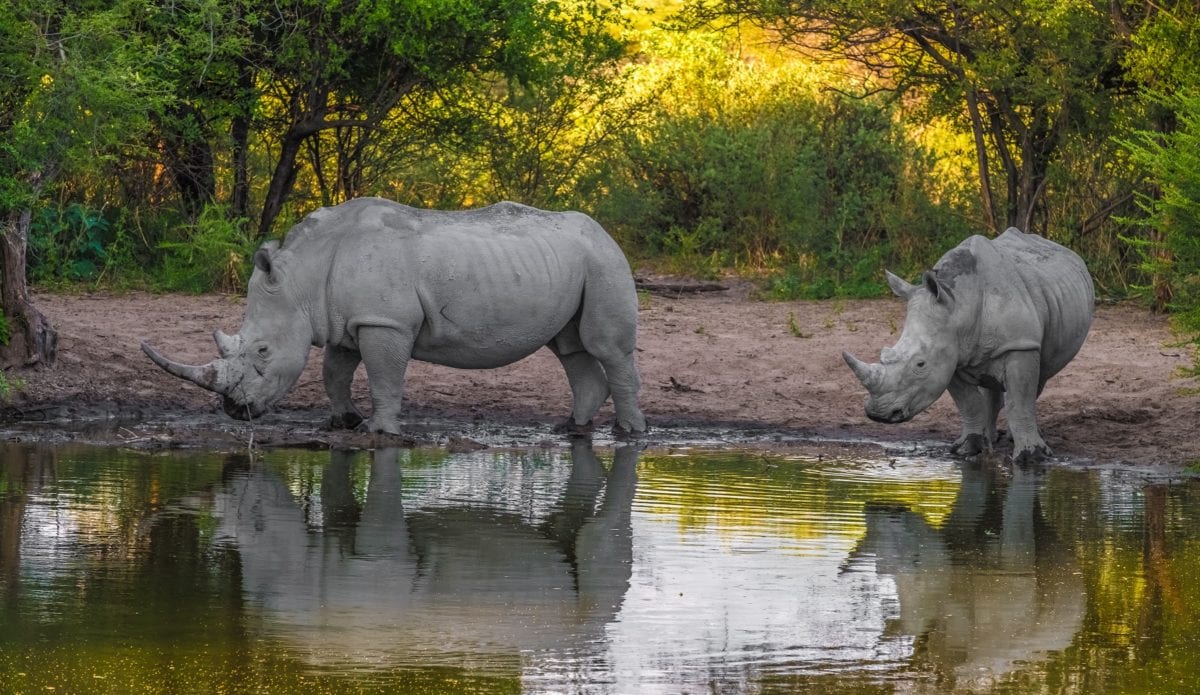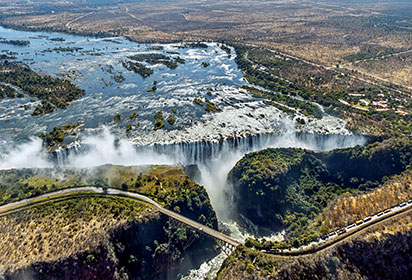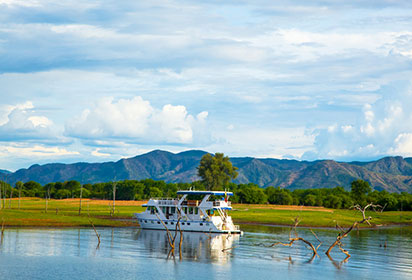It’s time to rediscover Zimbabwe’s stunning attractions and World Heritage Sites; from the magnificent Victoria Falls and Zambezi River to Matobo National Park’s ancient cave paintings; the game-rich national parks and Bulawayo’s local craft markets and, above all, to meet or reacquaint yourself with the country’s delightful people.
Paul Murray and Paul Hubbard, authors of Zimbabwe: the Bradt Guide
Zimbabwe’s recent political history is well documented and dealt a hammer blow to the tourism industry as visitors stayed away in droves. But the political developments of 2009 changed all that and there is a renewed vigour and vibrancy that has brought huge reinvestment in tourism infrastructure.
As I write this in Victoria Falls, I’m watching the sleepy little town of the last decade transform itself back into a bustling mecca for visitors from all over the world, just as it used to be.
True, Vic Falls and Hwange National Park with its abundance of wildlife are the current destinations of choice but already I’m hearing of people planning return visits to some of the lesser known, but equally stunning holiday destinations this country has to offer.
In Mana Pools, Gonarezhou and Chizarira national parks you’ll find unspoilt natural wildernesses like nowhere else in southern Africa. Lake Kariba which forms the northern border of Matusadona National Park offers a brilliant combination of freshwater ‘sea’ resorts and wildlife. Another of my favourites is Matobo National Park where you can visit easily accessible San rock paintings, some of the best examples of cave painting in the world.
The Eastern Highlands have fantastic scenery with fishing, hiking, golf and superb birdwatching as highlights – it’s nice and cool in the summer as well. Harare and Bulawayo are two very different cities – the first is chock full of restaurants, upmarket shops and artistic venues while historical Byo is laid back and friendly with great examples of colonial architecture.
And no vacation here is complete without a visit to the magnificent, but sometimes eerie, national monuments like Great Zimbabwe and Khami Ruins. All this plus its unfailingly welcoming and friendly people makes Zimbabwe once again, a ‘must-see’ destination.
For more information, check out our guide to Zimbabwe
Food and drink in Zimbabwe
Western food
Eating out in Zimbabwe was always excellent value, by which we mean very good quality yet inexpensive in international terms. More recently though, the virtual collapse of the agricultural industry means that good-quality raw materials generally have to be imported and in the process drive up prices. Expect around US$15–25 for a main course in a good restaurant. Virtually all restaurants and accommodations serve international menus with a heavy emphasis on steak, which is excellent in this country, and you’ll also find a variety of game meats on many menus. Vegetarians, generally speaking, have more difficulty finding an imaginative menu in what is essentially a nation of carnivores. Safari lodges and camps serve set meals so if you have any special dietary requirements be sure to advise them at the time of booking so they can accommodate you accordingly. Given the often-remote locations of these camps, don’t wait until you arrive before stating your dietary needs, as it will then be too late for them to cater according to your requirements.
Local/rural food
Once the country was not only self-sufficient in food, but also farmed in such abundance that it earned the sobriquet ‘the breadbasket of southern Africa’. Since 2000, economic and political instability, farm invasions and droughts have combined to turn the country into not only a net importer of maize but dependent on international food aid.
The staple starch for Zimbabweans is maize (mealie), although millet and sorghum are alternative grains grown mainly in the lowveld areas. Sadza, a heavy mash made from ground maize and water, forms the basis of every meal, supplemented with a relish – essentially anything that is available to impart a different flavour. Generally the sadza is rolled by hand into a small ball, moulded into a slight cup shape and dipped into the relish. Common relishes are vegetablebased, frequently green leaves like rape, either cultivated or collected wild, with tomato or onion if available. Groundnuts are grown and pounded to make a sauce with onions, something of a delicacy. Commercially produced fermented milk, known as lacto, is another popular relish. Chicken eggs are seldom eaten as they are needed to produce more hens. Maize cobs are commonly eaten roasted as a snack.
Rural Zimbabweans make great use of nature’s free resources, so wild mushrooms, fruits, seeds and wild plants are harvested. Their diet also includes a surprising number of insect species as protein sources – crickets and locusts, flying ants and a variety of caterpillars, not forgetting, of course, the plump and fried mopane worms. Cattle tend to be kept as an expression of wealth, and used as beasts of burden rather than a food source, although they are eaten following a ritual or ceremonial sacrifice. Other meat such as goat, mutton and chicken is commonly eaten depending on the wealth of the family. Nyama is the Shona word for meat, so you won’t go far in Zimbabwe before hearing the words sadza ne nyama, ie: sadza and meat stew, the standard meal for most Zimbabweans (including many whites). Needless to say, nothing is wasted, so stewed chicken heads and feet, bony off cuts and offal that would be considered unpalatable by many Westerners are all consumed. Fish from rivers and lakes include chessa, barbel or squeaker, fighting tigerfish, Kariba kapenta and, rarely, the huge vundu, the largest freshwater fish in the Zambezi, growing to over 50kg.
Urban Zimbabweans are more Western-orientated. Bread is popular, as are fast foods, especially fried chicken. Yet even in towns only a fool would try to separate a Zimbabwean, black or white, from their sadza.
Drinks
There’s a good range of Zimbabwean-brewed lager-type beers available and they come in either brown or green bottles. Brown beers such as Castle are ‘ordinary’ beers while green bottles such as Zambezi or Bohlingers denote premium beers carrying a slightly higher price. Imported beers command the highest prices. However, most local people purchase their Zimbabwean beer in cans these days rather than bottles. It’s quite common to have to pay a refundable deposit on glass bottles. Chibuku is the name given to local, mainly rurally consumed ‘beer’, a thick fermented concoction that is either brewed at home or commercially produced.
Bottle stores in large towns sell a range of imported South African wines. Zimbabwean wines, previously shunned by all but the desperate, have improved and you could sample the Private Cellar range or get hold of Bushman Rock.
All types of spirits are widely available with imported brands obviously commanding far higher prices. But with alcohol freely available in shops, supplies of mixers such as tonic water, ginger and soda can be erratic and you wouldn’t expect to find them in smaller towns.
The bars in the big Victoria Falls and Harare hotels are understandably expensive but generally speaking prices are reasonable and far cheaper than most European countries, although usually much higher than South Africa. A regular supply of safe drinking water from the taps remains problematic so bottled water is your best friend while staying in most towns. Check with your accommodation as they will normally supply clean, purified drinking water on request. Several of the upmarket lodges are eliminating water in plastic bottles in favour of refillable glass or metal containers from an in-house water filter.
Health and safety in Zimbabwe
Health
The economic meltdown in the decade of 2000 onwards had a dramatic effect on Zimbabwe’s health care system, resulting in chronic shortages of manpower, medical supplies and equipment, even in the capital, Harare. During the Unity government (2009–13), the situation improved but the country has subsequently slipped back economically. Public hospitals are still extremely understaffed and generally very poorly equipped. Well-run private clinics and hospitals can be found in Harare, Bulawayo and Victoria Falls and are capable of dealing with common emergencies but facilities in the rest of the country are sketchy and changeable. For serious conditions, evacuation to South Africa is invariably the best option unless the patient can’t be moved. Comprehensive medical insurance should therefore be a priority. Outside of towns and on safari, your lodge or camp will be well versed in first aid but will probably only stock basic medications. Rural clinics are rudimentary and cannot be relied upon for medical expertise, equipment or provision of medications.
Many fully inclusive lodges and tourism facilities subscribe to MARS (Medical Air Rescue Service), a private Zimbabwe-based medical service provider offering emergency road or air evacuation to the nearest medical facility. Control centres and medical teams around the country are on call 24 hours a day.
ACE Air and Ambulance provides a similar general service as MARS, but also another specifically tailored to the safari industry and has bases in Harare and Victoria Falls. Prior to booking your trip you may wish to enquire whether the places you plan to stay at subscribe to the above services.
Emergencies aside, Zimbabwe is a generally low risk in medical terms but of course with the proviso of malaria, which is endemic in large areas of the country that tourists are likely to visit. The country’s tourism sector has a long and enviable history of catering for ‘high-end’ visitors, so hygiene requirements are well understood and standards in camps, lodges and hotels are generally on a par with first world countries. That said, municipal water supplies have suffered greatly from under-investment and poor maintenance in recent years so be extremely wary about drinking tap water in town accommodations. Safari accommodations obtain water from boreholes, which provide some of the nicest water you are likely to drink. Pharmacies can be found in towns around the country but stocks will not be very comprehensive.
The incidence of HIV/AIDS is hard to gauge accurately, but in 2017 the estimated adult infection rate was 13.6%, with 1.3 million people living with AIDS. In 2017, new infections dropped to 41,000 from 2010’s figure of 79,000, with behaviour change, high treatment coverage and prevention of mother-to-child transmission services thought to be responsible for this decline. Deaths from AIDS-related illnesses continue to fall – from 61,000 in 2013 to 22,000 in 2017.
Travel clinics and health information
A full list of current travel clinic websites worldwide is available. For other journey preparation information, consult Travel Health Pro (UK) or Centers for Disease Control and Prevention (USA). Information about various medications may be found on Net Doctor. All advice found online should be used in conjunction with expert advice received prior to or during travel.
Safety
Nobody involved with Zimbabwe tourism can be in any doubt about the power of the international media, which effectively put the industry into a long hibernation between 2000–2013. We have been told in graphic detail that there is widespread violence, with murder, beatings, police brutality and torture. Zimbabwe must be a very dangerous place because even South Africans, who are quite prepared to live in one of the most violently criminal countries on the planet, are frightened to come here. Of course Zimbabwe has obligingly provided all the gory news fodder necessary to sell papers and have us glued to our television screens, and certain sections of the population have indeed had a horrid time for many years.
But, and it’s a big but, every scrap of that violence has been tied up one way or another with politics. This means that tourists are not – and never were – under any threat of violence, provided they keep clear of political activities.
By on what authority can we write this? Paul Murray has spent many years travelling in the country, while Paul Hubbard has lived in the country all of his life and has over a decade of experience in the tourist industry.
So what about normal crime? First, it’s almost inevitable that as soon as one starts to compile a list of anti-crime precautions, even though most of them are simple and very obvious, one is in danger of implying that the destination has significant crime problems. Zimbabwe, along with several neighbouring countries, has traditionally been virtually crime-free, to the extent that many rural tourist accommodations don’t even have locks on their doors. There are worrying reports of robberies and thefts in the larger urban centres and you should take all reasonable precautions as when in similar places anywhere else in the world. Despite the lack of current statistics, crime against tourists is generally minimal, not least because you will usually be in remote areas, and you should still look on Zimbabwe as an extremely safe country to visit.
With such a large proportion of the population being reduced to poverty and with a situation of extremely low (formal) unemployment, it’s no wonder that a very small minority have resorted to crime. This is nearly all property-related, with a significant increase in Harare’s residential burglary rate but, unlike in South Africa, virtually none of it involves gratuitous violence. Generally speaking, pretty well all of the few burglaries one hears of involve theft of items such as food, money and clothing.
Female travellers
Women travelling in Zimbabwe, either on their own or in pairs, are certainly safer here than in most other countries of the world. Provided you take normal, reasonable precautions you’ll find the place remarkably hassle free to travel through. Tourism is a major currency earner and employer, so most people are well used to respecting travellers of all sorts. Around town in the day, don’t forget this is a very conservative country so the usual dress sense applies: don’t wear provocative clothing, which generally means covering your shoulders and taking care not to bare midriffs or show too much leg – knee-length skirts and shorts, jeans and trousers are fine. If you do get a bit skimpy clothing-wise, while you won’t be at risk you will probably attract attention and be regarded in a negative light. Dress more conservatively in the evening and in bars or your intentions may be misconstrued. Where possible, team up with friends before you get to a bar, rather than waiting alone to meet them there. As always, laid-back Victoria Falls is something of an exception, where single women are extremely common (numerically speaking) and taken for granted.
As a lone, female traveller any attention you may attract will almost certainly be purely inquisitive. The way you are travelling (ie: without a man) tells people that you are clearly a very capable person and the very opposite of vulnerable. Basically if you can fend off an unwelcome advance in London, New York or Paris you will have no problem in Zimbabwe.
That is not to say that you will not be an object of great interest to both men and women. Africa is generally very conservative and male dominated, with women having definite roles in life, none of which involve swanning off around the world without a man. Two of the first questions you will invariably be asked are ‘Where is your husband?’ and ‘How many children have you got?’ This is all very important information and tells them a lot about you. Big families are good news in Africa; everybody has them so where are your children? You shouldn’t get too defensive about this because men too are expected to father children and we frequently get asked about the number of kids we have.
Depending on their age, childless women travellers may want to invent a husband and a child or two because women of marriageable age who decide not to have children are generally regarded in African cultures as lazy or even worthless. Similarly, men without children are usually considered inadequate. For either gender to choose not to have any children is virtually incomprehensible.
Finally, a word of advice: sanitary products have been notoriously absent from Zimbabwe’s shop shelves in the last few years and although the situation has greatly improved it would still be wise to take sufficient stocks with you for your whole trip.
LGBTQ+ travellers
Zimbabwe, in common with most African countries, has an extremely conservative attitude towards homosexuality, and political and religious leaders here regularly use the words ‘homosexual’ and ‘gay’ as terms of abuse. So what are the implications for gays and lesbians visiting the country?
In Zimbabwe, homosexual sex remains a criminal offence for men but not for women. Cross-dressing for men is illegal. There is a constitutional ban on same-sex marriage too, upheld by the supreme court in 2019. Nevertheless, if you are discreet, you are very likely to be safe although, for men, there is a good possibility of being blackmailed if you have sex with a local person with fewer resources than yourself.
Zimbabwe is not uniformly homophobic and an urban generation is now growing up with the knowledge that gay and lesbian people exist in their midst, but it is still best to be very discreet about your sexuality unless you are sure you’re in safe company. Sleeping arrangements should not be an issue as you are in the privacy of your own room.
Anti-gay sentiment is not usually expressed in terms of physical violence but can result in verbal abuse. According to a 2018 survey, 50% of gay men in Zimbabwe had been physically assaulted and 64% had been disowned by their families; 27% of lesbians also reported disownment. There is also the common, foolish misconception that being gay immediately equates to paedophilia. White local males tend to have a very macho outlook on life and few will have had any contact (knowingly) with gays, and it’s not uncommon to hear anti-gay jokes and comments voiced in public.
There are no gay clubs or bars and there are very few, if any, that can be described as gay-friendly. If you want to be in a club with other gay or lesbian people, it is best to make arrangements beforehand. It is not known what the HIV prevalence rate is among the local gay community but you are advised to use protection at all times, since the prevalence is likely to be higher than in the general population, which itself has much higher rates than in the West.
Contact GALZ (Gays and Lesbians of Zimbabwe) for more information and advice.
Travelling with children
Zimbabweans love children and are generally extremely accommodating and helpful to families; and the country is without doubt an exciting place for children to see wildlife up close, bringing those television nature programmes dramatically to life. However, if you are planning a holiday to include a significant amount of wildlife viewing there are a number of issues to take into consideration. First, you’ll need to check whether there is a minimum age at the places you want to stay. Minimum age limits vary between six and 16 years old. If on a walking safari in a dangerous game area, the usual lower limit is firmly set at 12 years old.
The age limits are set in place for good reasons: in wildlife-rich areas, animals routinely enter the unfenced grounds of safari camps/lodges, so children will need constant supervision. When out on safari, close encounters with wildlife are naturally very exciting for children – however, noisy and impulsive reactions are likely to startle wildlife and thereby jeopardise the enjoyment, or even the safety, of everyone. You’ll often find game drives catering separately for people with children. One tip — pack one pair of binoculars for each child; it will keep them interested and engaged during any trip to a game park.
Second, a typical wildlife-viewing day has several hours of ‘down time’ between morning and evening activities and since safari camps tend by their very nature to be in remote areas, some children may get bored.
Several lodges and companies are introducing special sections of their properties for families travelling with young children, replete with specially designed rooms, creative activities, specialist guides and flexible schedules to enable you to enjoy your time together to the fullest. Inter-connected rooms on raised platforms, walkways to main areas, extra staff to assist, and private game drive vehicles are some of the facilities being added to entice families to travel together. Babysitters are also now often on call in many camps.
Disabled travellers
People with physical disabilities may find it rather difficult to enjoy many of the popular attractions of Zimbabwe. Towns are usually fairly navigable by wheelchair, although pavements can be uneven and frequently non-existent, with only the alternative of travelling on the side of the road itself, which may very well be pot-holed. Many people will feel distinctly uneasy at this prospect, given traffic volumes and the fact that drivers feel they have an absolute right of way. Crossing roads can be an issue as there are frequently deep storm gullies requiring a detour to the next ‘bridge’. Dropped curbs exist in a few of the larger towns but even here they seem to be completely unplanned so you never know where the next one will be.
Although most upmarket town-centre accommodations and facilities are wheelchair-friendly and becoming increasingly so, many of the wildlife-related venues are in remote areas and specifically designed to blend in with natural surroundings that do not readily lend themselves to wheelchair access. In practical terms this means there can be long distances between chalets and the central guest area and paths can be steep, often involving flights of steps, areas of sandy ground, rock-strewn paths and all manner of obstacles. Many lodges do, however, have relatively accessible accommodation facilities in the rooms closest to the main building.
The point that has frequently been made to us is that virtually everyone comes for the wildlife viewing but people with physical disabilities cannot be catered for as the vehicles used are completely inaccessible to them. Therefore there is – they reason – no necessity to make adaptations to their buildings or grounds. The problem with this approach is that it assumes that everyone with a disability is completely physically incapable. Access to these high, open wildlife-viewing vehicles can indeed be difficult, requiring a degree of agility to climb in, but with assistance a lot of folk can manage it.
Travel and visas in Zimbabwe
Visas
Visas and entry requirements are subject to change and you should always contact the Zimbabwean embassy or consulate in your country for the latest information. Zimbabwe government websites may not be up to date and should not be relied upon.
You may or may not require an entry visa, depending on your nationality. If you do need one you may be able to purchase it on entry to Zimbabwe, otherwise you have to obtain it in advance – again, this depends on your nationality.
Nationals of 45 countries including the following do not require visas: Angola, Antigua, Bahamas, Barbados, Belize, Botswana, Cayman Islands, Cyprus, Democratic Republic of Congo, Eswatini, Fiji, Ghana, Grenada, Hong Kong, Jamaica, Kenya, Lesotho, Madagascar, Malawi, Malaysia, Maldives, Malta, Mauritius, Montserrat, Mozambique, Namibia, Seychelles, Singapore, St Lucia, St Vincent and the Grenadines, South Africa, Tanzania, Tonga, Trinidad and Tobago, Turks and Caicos Island, Uganda, Zambia.
Nationals of 90 countries including the following may buy a visa on arrival: Albania, Algeria, Argentina, Australia, Austria, Belarus, Belgium, Bermuda, Brazil, Bulgaria, Canada, Chile, China, Denmark, Egypt, Finland, France, Georgia, Germany, Greece, Hungary, Iceland, India, Indonesia, Ireland, Israel, Italy, Japan, Kuwait, Liechtenstein, Luxembourg, Monaco, Netherlands, New Zealand, Norway, Poland, Portugal, Puerto Rico, Russian Federation, South Korea, Spain, State of Palestine, Sweden, Switzerland, United Arab Emirates, UK, USA, Venezuela.
Nationals of 80 countries including Bangladesh, Guyana, Pakistan, Philippines, Sri Lanka, Taiwan, Thailand require a visa to be obtained before travel. This can be obtained by visiting a Zimbabwe consulate or you can do it online. Note that you can only buy a single-entry visa.
KAZA tourist Univisa Zimbabwe and Zambia have reintroduced a KAZA tourist Univisa costing US$50 which allows visitors of 65 nations to cross between the two countries as often as they like during the 30-day validity. It also allows day visits to Botswana via Kazungula but not overnight stays.
Getting there and away
By air
At the time of writing, Emirates and Ethiopian Airways were the only longhaul carriers flying into the country, with flights between Harare and Dubai, and Harare and Addis Abba respectively. As a result, many overseas passengers fly to Johannesburg, connecting the same day to Harare, Victoria Falls or Bulawayo.
In early 2016, the greatly enlarged, new Victoria Falls airport terminal with lengthened runway opened its doors. This major enhancement allowed it to accept large capacity aircraft and it is hoped that it will become a potential competitor to Johannesburg as a major regional hub, although we still wait to see which major international airlines actually commit to using it. Flights between Cape Town and Victoria Falls are increasingly available.
The government has announced ambitious but fanciful plans to refurbish and reopen airports across the country, from Masvingo and Chiredzi to Hwange and Nyanga, but little has currently happened on this front beyond over-hyped press announcements.
South African Airways operates daily direct to Harare, Victoria Falls and Bulawayo with a flight time of around 2 hours. British Airways (Comair) flies daily direct to Harare and Victoria Falls. Air Zimbabwe also operates daily flights to Harare and Bulawayo.
By bus
Several luxury, air-conditioned coach services regularly ply the route between Johannesburg and Bulawayo and Harare, with a driving time of approximately 13 and 17 hours, respectively. Most operate mainly during daylight hours, but a couple are overnighters. Given the hazards and the standards of Africa’s roads, our inclination would be to choose a daylight service whenever possible.
By road
When driving from South Africa, most people feel (usually wrongly) they are committed to entering at Musina/Beitbridge. Although the border is open 24 hours, allow a lot of time for formalities at this very busy border so that, once through, you still have at least an hour’s daylight to reach the first possible overnight accommodation on the way to Masvingo or Bulawayo.
The Zimbabwe side of the border has an appalling record for confusing signage, horrendous queues and notorious ‘helpers’, ‘facilitation agents’ or more accurately unofficial touts, who ‘offer’ to speed you through the process at an exceptionally high price of several hundred dollars. The more you use these persistent rip-off artists, the more you encourage them. But if you don’t use them you can queue for hours.
This situation has been allowed to continue for many years due to the rampant corruption at this border post which clearly goes right to the top. However, you can usually dramatically cut your delays here by arriving at the border before 09.00, preferably avoiding weekends. In order to alleviate the hassle of negotiating this place, ZTA has instigated a system whereby given prior notice of your arrival, they will meet you and escort you through the whole process.
If you are heading from South Africa to Victoria Falls or Bulawayo, you can completely avoid the hassle at Beitbridge by crossing into Botswana at Groblers Bridge/Martins Drift and entering Zimbabwe at Plumtree, Pandamatenga or Kazungula. Plumtree, although busy, brings you in close to Bulawayo; Pandamatenga is convenient for the northern part of Hwange and Victoria Falls (4x4s only); and from Kazungula you have a pleasant 50-minute drive to Victoria Falls.
Getting around
By air
With the drastic reduction in Air Zimbabwe’s routes, they currently operate just one daily flight covering Harare/Bulawayo/Victoria Falls. The African lowcost airline fastjet operates Harare to Victoria Falls, and Harare to Bulawayo with no frills (ie: everything charged extra).
A number of private, light-aircraft charter operators are now available to fill some of the gaps. However, these have been set up mainly to service the ‘high end’ remote camps and their fares are pitched accordingly. In 2019, Safari Logistics launched a daily flight service (with a minimum of two passengers) connecting Mana Pools, Kariba, Harare, Victoria Falls and Hwange. They use a variety of light aircraft, with several stops along the way, but, because it’s charged by the seat, this service is much cheaper than individual charters. One hopes the uptake will make it an enduring facility.
Self-drive
Self-driving is really the only way for truly independent travellers to get around. It gives you the freedom to plan your own route, itinerary and accommodation, and eat wherever you like, and you can visit areas that few tourists have even heard of.
Zimbabwe is an easy, friendly and pleasant country to drive in. Its network of tarred roads is in quite good condition, due largely to light traffic volumes during a decade of fuel shortages although pot-holes are emerging quite rapidly so caution is always advised. There was a spurt of road improvement in 2014 that resulted in the resurfacing of the road from Plumtree all the way across country to Mutare via Bulawayo and Harare.
Petrol and diesel are no longer easily available anywhere in the country at the time of writing, and long queues are now the norm. If you hire a car, the company should be able to help you source fuel in the main cities. In Harare and Bulawayo, there are garages selling fuel for US$ only, although even there supplies remain erratic.
A thriving black market in fuel dealing has grown although if you decide to buy from unregistered operators, be aware that the fuel may be riddled with contaminants, including water, that may damage your engine. Always check the quality before allowing anything to be poured into your tank. If you are unsure, rather reject it than risk a breakdown. Even if you need low sulphur (50ppm) diesel it may be best to take what you can get rather than running dry. Of course, you should check in the vehicle handbook to see if this is an option.
When to visit Zimbabwe
When to visit
Zimbabwe offers a generally very pleasant year-round climate, but the best time to visit depends on which activities you wish to pursue and which regions you want to visit.
For more itineraries see the Zimbabwe safari holidays on SafariBookings.
For wildlife
To maximise wildlife viewing, the dry, winter months of July–October are the best. In the dry season, natural water sources become scarce in the bush, encouraging game to congregate around a relatively small number of artificially pumped pans or waterholes near lodges and specific game-viewing areas.
In the summer rains, surface water is generally abundant so animals get all they need in more natural circumstances, but as the game becomes dispersed you will tend to see far less. At this time of year, vegetation becomes much more luxuriant, acting as an effective screen severely restricting your view into the bush.
If your interest is in birdlife, Zimbabwe offers excellent all-year viewing but the summer months are outstanding as the count swells considerably with the arrival of migrants. Think in terms of 650 species countrywide. Some safari camps and national parks close down altogether in the wet period immediately after New Year.
For waterfalls
Victoria Falls will no doubt feature in your first visit. During and after the rains in the Zambezi catchment area in March–June, the falls are full and totally awesome. But your experience consists of massive amounts of thundering spray and little else. It can be virtually impossible to see anything of the actual waterfalls. In the dry season (the time most visitors arrive for wildlife viewing) the water volume is reduced to a relative trickle over some of the cataracts, but you are rewarded with awesome views of the gorges and their fascinating geological structure. For the best of both worlds, visit in June to August even though this is a little early for prime wildlife viewing.
For watersports
For Zambezi river-based adrenaline activities such as whitewater rafting and kayaking, the low water levels during winter (August–January) are best. At high water (May–July, January–March), rafting is restricted to the lower run of rapids, numbers 11–23, as the river is too full and fast for the complete series. After very heavy rains (March–April), these activities are prohibited altogether until water levels subside. Please note that the above dates are totally dependent on rainfall levels in the catchment area so can vary considerably.
Kariba and the Zambezi Valley offer water-based activities, boating and canoeing year-round, but these are best enjoyed outside the hot, humid summer months.
What to see and do in Zimbabwe
Chizarira National Park
Chizarira weighs in at 1,920km², Zimbabwe’s third-largest national park. It’s in the northwest of the country, just south of Lake Kariba, and with its escarpment, deep gorges and pristine forests it is, in many people’s eyes, the most scenically beautiful and dramatic park of all. The average elevation is around 1,000m, rising to 1,433m at the summit of Tundazi Mountain. It was proclaimed a non-hunting reserve in 1958, and the national park was established to give sanctuary to wildlife driven out of the valley by the rising waters of Lake Kariba.
Chizarira shares a reputation with Gonarezhou as a true wilderness area. Its name derives from the Tonga word sijalila (‘great barrier’), a reference to the mighty and near-vertical 500m Zambezi Escarpment. The park encompasses no fewer than seven ecological zones, ranging from lowveld valley vegetation to highveld broadleaf woodland. From the escarpment the Zambezi valley floor extends southwards through rolling hills and valleys to merge with the low-lying Busi region. Springs and seeps provide water and surprisingly lush pockets of vegetation between ridges of mountain acacia and the red-plumed Prince-of-Wales feathers plant, often cultivated for its edible seeds. Down on the floodplain you’ll find a remarkable similarity to Mana Pools, with towering evergreens and lush vegetation surrounding deep pans.
For the past several years, the condition of the roads and the high incidence of poaching were two limiting concerns for visitors to the park. The good news is that from early 2018, three organisations have committed to working with National Parks to bring Chizarira back to its former glory. UK-based nonprofit National Park Rescue and Zimbabwean non-profit Bhejane Trust are rebuilding the roads and training and assisting with anti-poaching patrols. The African Lion and Environmental Research Trust (ALERT) is leading a lion research project and assisting with the upgrade of some facilities. Several roads have been reopened and marked in the north of the park with plans to expand this upgrade throughout the park. A 4×4 is still recommended for all visitors and there are plans to create challenging trails specifically for 4×4 enthusiasts.
Although the condition of the roads is improving, most remain rugged. Indistinct tracks, washed-out riverbeds, deep ruts and rocky inclines, and trees pushed over by elephants all make for a difficult driving experience. In the wet summer months the park stays open for visitors but many roads and tracks are impassable, with generally only Muchene and Kaswiswe camps accessible. Having said that, the main road from the northern entrance south to Lesulu is well maintained throughout the year, as this is the main access route for rangers on anti-poaching patrols.
Accommodation is another limiting factor. There is currently no lodge accommodation anywhere near the park so camping is the only option, and you need to be completely self-sufficient. Nevertheless, there are some stunning places to overnight, and small thatched shelters at several of these sites mean that you can often do without a tent, at least in the dry season.
Finally, in times past, this quiet and somewhat cash-starved park gained an unfortunate reputation as a free-for-all for poachers. While the anti-poaching work is beginning to have a positive effect, the remaining elephants remain in a pretty aggressive frame of mind, so they should be treated with even more caution than those in Hwange and Gonarezhou. Much of the other wildlife is skittish and fearful. There used to be a large population of black rhino here but after most had been poached the few remaining individuals were captured and relocated to Matusadona.
While this is not yet a park with heavy concentrations of game, there are good populations of leopard, lion and hyena, and plenty of food for them in the form of buffalo, impala, tsessebe, sable, kudu, roan and other buck. The park also features high on the list for enthusiastic birdwatchers, who come here to find, among its estimated 368 species, African broadbill, yellow-spotted nicator, Livingstone’s flycatcher and emerald cuckoo. The rare Taita falcon has been seen flying and roosting around the cliffs in the escarpment area, and it’s in the forested parts of the park near the entrance gate that the brilliantly colourful yet inconspicuous African pitta, almost a holy grail for birders, has occasionally been seen hopping around in the undergrowth. All in all, Chizarira’s real strength is as a destination for hikers and others who want to experience one of southern Africa’s rapidly dwindling, truly wild and rugged places.
One of the best ways to explore this park is with a safari operator who will take you walking deep into the wilderness where few tourists ever go. The most experienced guide operating in this area is Leon Varley of Leon Varley Walking Safaris who considers this to be his ‘home park’. It’s also possible to hire a park ranger as a guide (it will be in your own vehicle), but to be sure of availability you should book in advance from National Parks headquarters in Harare.
Late afternoon and sunset bring a succession of orange to deep red tints to the Chilojo Cliffs © Paul Murray
Gonarezhou National Park
At a fraction over 5,000km², this is Zimbabwe’s second-largest national park, established in 1975. The name translates from Shona as ‘place of elephants’. The river floodplains are interspersed with lagoons and riverine forest featuring notable species such as the nyala berry tree, ebony and Natal mahogany. The arid hinterland comprises mopane woodland and ironwood forest, as well as the succulent shrub, the Sabi star, which grows on rocky outcrops and has a lovely pink flower. These varied habitats are responsible for the richest biodiversity of any Zimbabwe national park. Gonarezhou has the biggest variety of birds in the country – over 400 species, with a further 92 listed as ‘likely to occur’ – but do note that birding on foot is not allowed without a registered guide. The most scenically dramatic areas are along the Runde River with the majestic, red sandstone Chilojo Cliffs being the most iconic feature. Here, the seasons present two very different aspects – in the dry winter months your photographs will show the cliffs towering over the parched river bed with elephant marching from one side to the other and made miniature by the sheer size of the geography. When the river’s in flood though, you could be forgiven for thinking you were in a different park altogether. This is a huge river system that transforms a dry, apparently lifeless landscape into a lush and verdant wildlife paradise.
The game has had a difficult time of it in the past. Elephants, along with much of the other ‘game’, suffered from widespread hunting and poaching in the early 20th century, and later from Mozambican troops who during their civil war treated Gonarezhou as a food source and a sporting paradise. The sport consisted of terrorising all and any game by shooting from both ground vehicles and helicopters. To make matters worse, widespread poaching continued late into the last century by neighbouring communities who continued to resent the incursion of the national park into their traditional lands. This history has given Gonarezhou a reputation of being short on wildlife and many Zimbabweans (few of whom have visited the park recently) still think this is the case. Many also believe that GNP’s elephants are not only scarce but notoriously ill-tempered and dangerous as a direct result of their continued persecution. Inevitably in a park of this size, poaching continues to exact a toll, but there is now a great deal of good news too.
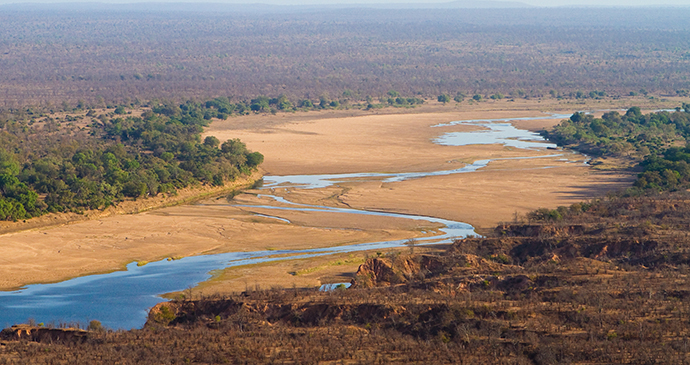
In operation since 2017, the Gonarezhou Conservation Trust is now directly responsible for management of the park (and will be for the next 20 years). The improvements so far have been incredible and, presuming they continue as they seem certain to do, showcase a management model that benefits the entire surrounding community, and which could revive and reinvent national parks across the continent.
Gonarezhou is also part of the Great Limpopo Transfrontier Conservation Area, encompassing Kruger National Park in South Africa and Limpopo National Park in Mozambique, offering the prospect of opening up the border fences and allowing game to migrate over much larger areas. This project has not yet reached completion, with a number of funding issues to be resolved, as well as the not inconsiderable problem of the perfectly reasonable unwillingness of GNP’s elephants to set foot in Mozambique territory. They do indeed have good memories.
Keen birders will want to spend several days in this park, which boasts an impressive list of specials, including African finfoot, bat hawk, racket-tailed roller, thick-billed cuckoo and Pel’s fishing owl, to name just a few. As this park has predators, birders on foot must employ a National Parks or registered guide.
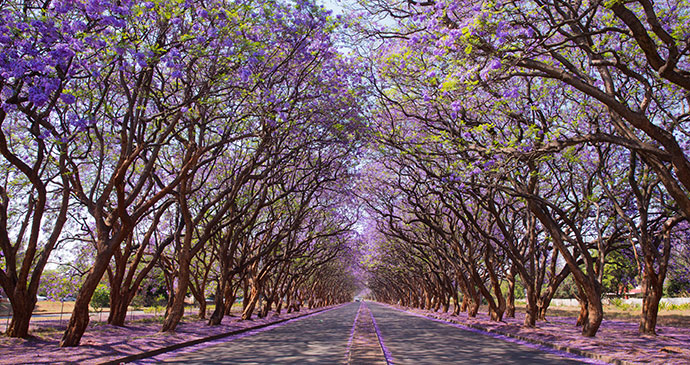
Harare
Harare is one of the most laid-back capitals in the world. With so many great restaurants, friendly and helpful citizens, easily accessible tourist sites and fabulous accommodation options, it remains a favourite ‘best-kept-secret’ diplomatic posting for many embassy staff, despite their generous ‘hardship’ allowances.
After the difficult decade of 2000–2009, and following the introduction of the unity government, Harare’s tourism sector began to pick itself up with a degree of optimism. But that effect was temporary and was soon to be superseded by the rapidly deteriorating economic situation which saw many businesses fall by the wayside, and the desperate water and power supply situation was only making matters worse. Even now though, Greater Harare (estimated population 2.2m) is a very pleasant town with plenty of parks and open spaces, wide streets lined with jacaranda and flamboyant trees, and pedestrian areas with upmarket shops and craft markets. It enjoys a thriving arts scene with galleries and museums, trendy restaurants and nightclubs; in fact pretty well everything you would expect in a capital city. But today you can’t help noticing the general feeling of decline in parts of the CBD. Traffic congestion, together with the closing down of many shops and restaurants and an increase of informal traders, has turned Harare into a city of two parts. The wealthy folks are still in town but over the years they have migrated to the leafy suburbs to the north where you’ll be surprised at the obvious affluence reflected in the beautiful private properties and the upmarket shopping centres that service them.
The city centre still has some attractions of interest to the visitor but generally speaking you’ll be drawn to the suburbs such as Avondale and Borrowdale for the best accommodation, shopping and dining.
One of the finest national parks in Africa, Hwange contains a remarkable diverstiy of wildlife, including one of the largest elephant populations on earth © Paula French, Shutterstock
Hwange National Park
Hwange ranks among the top national parks in Africa in terms of size, and sheer numbers and variety of game, along with excellent viewing and accommodation facilities. If this trip to Zimbabwe is your first experience of African wildlife viewing, Hwange is the perfect place to start your quest for the ‘Big Five’, before moving on to other equally rewarding animals. With over 108 species, Hwange boasts the highest diversity of mammals of any national park in the world, including 19 large herbivores and eight large carnivores. One of the largest elephant populations on Earth – numbering anywhere between 20,000 and 75,000 in the peak dry season – ranges between Hwange and neighbouring Chobe in Botswana. Over 400 species of birds have been recorded here, including around 50 types of raptor.
Hwange today is part of the KAZA (Kavango-Zambezi Transfrontier Conservation Area) region, the largest conservation area on the planet. The park was included because of its incredible biodiversity.
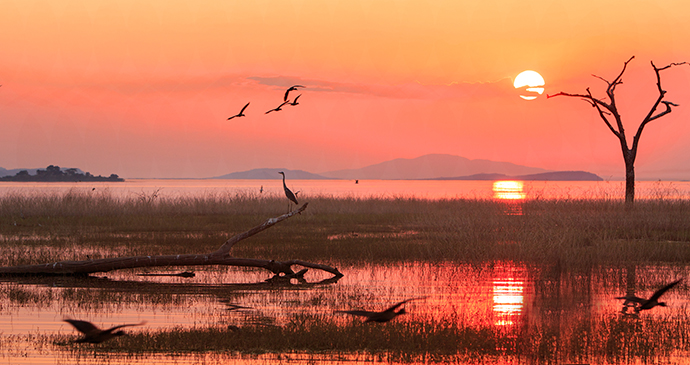
Lake Kariba
Lake Kariba, one of the world’s largest manmade expanses of water, is Zimbabwe’s ‘seaside’ in a landlocked country, and tends to be viewed more as a holiday destination for locals than for overseas visitors. The lake features its own accommodation speciality, the houseboat, so Zimbabweans flock here with family and friends for fishing, boating or just to chill out with a crate or eight of beers (although ‘chill out’ may be misleading in this area of stifling summer temperatures and humidity).
If you let Zimbabweans have this vast area to themselves, however, you’ll be doing yourself a great disservice. Kariba is a laid-back holiday playground with a wide choice of water- and land-based activities. The area provides some stunning scenery and the big-sky sunsets over the lake are legendary, attracting keen photographers worldwide. There can be few better ways of lowering your blood pressure than a sunset boat cruise, weaving through the eerily stark treetops that remain a full half-century after the river was dammed. Its southern shore forms the northern border of Matusadona National Park so it’s a brilliant base for wildlife viewing and birdwatching, both of which can be done on land or from small boats or canoes that allow you to approach within metres of bathing elephant and buffalo slaking their thirst.
If you find a houseboat too big for your needs, or you prefer to stay on dry land, there are some fine lodges along the east and southern shores catering for most budgets.
Mana Pools National Park is deservedly one of Zimbabwe’s most popular wildlife destinations © Claudio Soldi, Shutterstock
Mana Pools National Park
Entry to this park – a UNESCO World Heritage Site – is strictly controlled by the Zimbabwe National Parks and Wildlife Management Authority. Prior booking is essential, through an operator or directly with ZPWMA.
The park is actually part of a much larger wildlife area adjacent to Sapi and Chewore safari areas to the east, also bordering the Zambezi. Not only is Mana Pools richly stocked with game and blessed with outstanding scenic, riverine beauty but it is also relatively little visited, at least compared with Hwange and Victoria Falls. This is one of the few national parks where visitors are allowed to walk at their own risk along the floodplain but while this is welcomed by enthusiasts with plenty of bush experience, it is most advisable for inexperienced visitors to be accompanied by an armed professional guide or a national park ranger. Probably because of its outstanding qualities as a game-viewing destination, this park is home territory to some of Africa’s finest professional guides.
Limited fishing is allowed, but only from land. Motorboats are not permitted in the dry season because of noise, pollution and wave action disturbing the wilderness qualities of the park. A thorough ‘Respect the Wild’ code of conduct for visitors to Mana Pools and other wild areas is displayed at accommodation points throughout the park; visitors are advised to take heed of its advice to get the best out of their wild experience and to ensure they leave the area as they found it. A fine of US$1,000 may be applied if you are found in breach of the regulations. In 2012, this was the first of Zimbabwe’s national parks to adopt the excellent ‘carry in – carry out’ rubbish policy, which has been rigidly enforced. You are asked to burn anything combustible on your campfire but for non-combustible materials you will be given a plastic bag and expected to deposit it at an urban centre away from the park. There are no disposal facilities at the exit of the park and if you leave your rubbish there you will be fined.
There are no shops, and cellphone coverage is very limited. Accommodation is restricted to a handful of safari lodges and eco-friendly tented or mobile camps as well as self-catering national park chalets. Camping on the banks of the Zambezi River is a feature of the Mana experience.
The park is open to cars during the dry season but during the rainy season roads are frequently closed. Access to the interior of the park is restricted to the main road to Nyamepi Parks HQ from December to March. The best time to come here in terms of temperature and rainfall is March to October.
Owing to the fact that this is a UNESCO World Heritage Site, an integral part of the UNESCO Middle Zambezi Biosphere Reserve and a designated Ramsar Wetland of International Importance, the area has recently been saved from a proposal to mine for heavy metals that were thought to be deposited in the park’s riverbed. There remains a long-term potential threat for its future because of plans for the Mupata Gorge hydro-electric scheme that would flood the entire area for electricity generation. At present, focus is on the Batoka Gorge Dam while funding is unlikely to be forthcoming for development in this area. Check the Zambezi Society’s website for updates as well as advice for visiting this area in a responsible, ecologically aware manner.
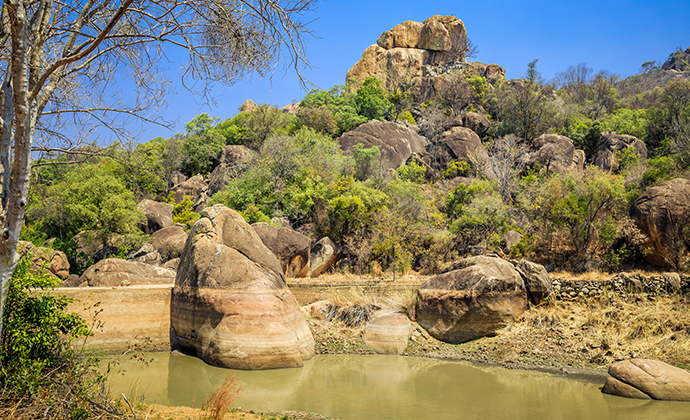
Matobo National Park
Less than an hour’s drive south of Bulawayo lies one of Zimbabwe’s, if not southern Africa’s, most dramatic rock landscapes. To describe this area, which includes the Matobo National Park, as a place of outstanding natural beauty is something of an understatement. Copywriters struggle to convey the geological majesty of the place, with adjectives from ‘rugged’ and ‘domineering’ to ‘spiritual’ and ‘weird’.
Granite is the building material and weather the artist. The area gets your attention with two completely different rock forms, both the result of the same geological processes. Most dramatic are the balancing rock kopjes: huge angular blocks of granite piled on top of and beside one another, forming pillars and stacks, like a giant child’s building blocks. Most dramatic in scale, however, are the massive, bald dwalas or ‘whalebacks’, grey granite hills rising from the surrounding woodland and criss-crossed with fault lines, some so intricate they look like giant hieroglyphics. Matobo, in fact, is translated as ‘bald heads’, allegedly coming from a joke made by King Mzilikazi.
Hundreds of caves and rock shelters created by the same weathering processes were later inhabited and painted by descendants of the world’s most ancient peoples; indeed this is one of the few areas in the world proven to have supported continuous human occupation for over 40,000 years.
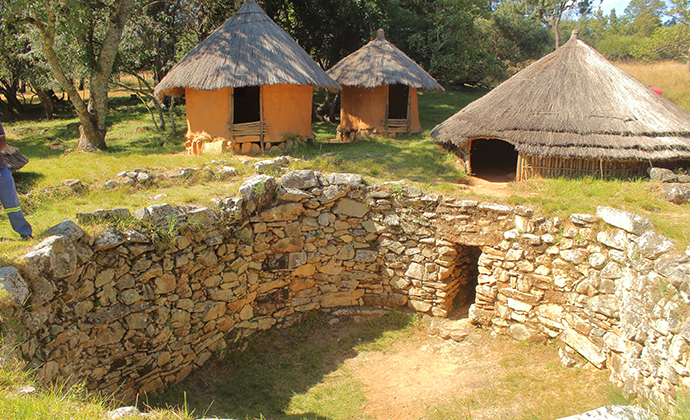
Nyanga National Park
The park and the Nyanga Highlands rise to 2,592m at Mount Nyangani, Zimbabwe’s highest point. The area (314km²) is characterised by rolling hilltops studded with huge, smoothly rounded granite outcrops towering over steep gorges and wide valleys. The Pungwe River has carved a spectacular route southwards and eastwards from the foot of Mount Nyangani, while further south the Honde River has created a wide fertile valley beneath the dominating escarpment along the border with Mozambique. Zimbabwe’s highest waterfall (and Africa’s second-highest), the Mtarazi Falls, drops 762m into the Honde Valley.
This part of Zimbabwe has been populated since the dawn of humanity and today is rich in archaeological sites, including remnants of Iron Age villages and hilltop forts. There are three principal villages in the region: Juliasdale, west of the Nyanga National Park; Nyanga to the northwest; and Troutbeck close by in the north. Excellent tourist accommodation, from camping to luxury, is scattered throughout the area, and numerous roads and dirt tracks give access to remote, breathtaking viewpoints. The dirt roads here are in better shape than some further south, but you will still benefit from a high-clearance vehicle, and a 4×4 in the rainy season.
Hikers and birders are drawn to this area, and fishing is a big pull for many, with rainbow and brown trout in the many rivers, streams and reservoirs. There is a variety of game in the national park, including blue duiker and samango monkeys, but it is sparsely distributed and hard to spot. You are most likely to spot klipspringer, reedbuck, wildebeest, zebra, bushbuck and kudu, notwithstanding imaginative reports of sightings of lion and buffalo, which do not actually occur in the area.
It won’t take long before you come across the name Cecil Rhodes (the national park is still often referred to as Rhodes Inyanga). He actually bought a large chunk of the area for himself and built a house overlooking – you guessed it – Rhodes Dam; this is now the Rhodes Nyanga Hotel.
Spectacular though this area is, it would be unrealistic not to mention the extensive commercial forestry here. Depending on growing and harvesting cycles you may find yourself driving through mile upon mile of monotonous plantations or past blackened hillsides full of smouldering tree stumps. Illegal fires in the winter season also burn off the grasslands in the park, despite the best efforts of the rangers to stop such events.
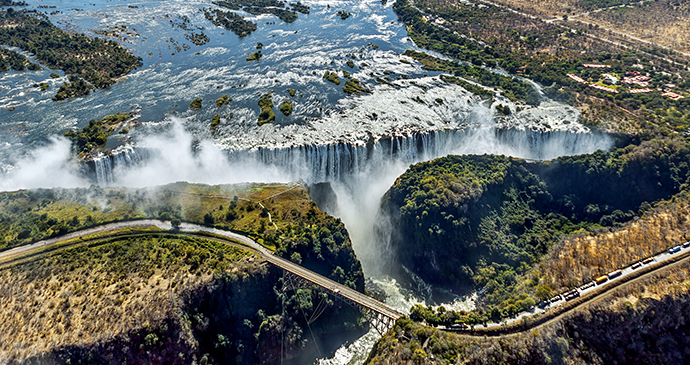
Victoria Falls
Every single commercial tourist itinerary to Zimbabwe includes Victoria Falls – and quite rightly too. The town is famous for its magnificent waterfall, which is not only a World Heritage Site but is listed as one of the ‘Seven Natural Wonders of the World’. As if that wasn’t enough, it supports a huge array of adrenaline-fuelled activities from the famous white-water rafting to bungee-jumping and gorge swinging. Tamer activities are also being popularised, including game drives, boat cruises, historical explorations and outdoor fine-dining experiences.
Even today, with Zimbabwe having suffered 20 years of political and economic strife, it’s difficult to imagine a more complete African tourist destination than Victoria Falls (commonly referred to as ‘Vic Falls’ or simply ‘the Falls’). As well as the adrenaline sports, both aerial and waterborne, the area offers a wealth of traditional wildlife-based and cultural attractions. While some visitors seek excitement others still prefer the genteel life of yesteryear, with starched waiters, afternoon tea on manicured lawns or sipping gin and tonics on a peaceful river cruise serenaded by grunting hippos.
Make no mistake, tourism has turned this far western tip of the country into a very un-Zimbabwe-like place, but its relative isolation coupled with its revenue earning reputation has left it less affected by the political troubles and interference experienced elsewhere in the country. It is testament to the commercial nous of the operators here that while the rest of the country has once again entered into economic freefall, many sectors of the Victoria Falls tourist industry have stayed buoyant, even flourishing. Although many small operators have fallen by the wayside, others have amalgamated or built on specific strengths and grown their markets.
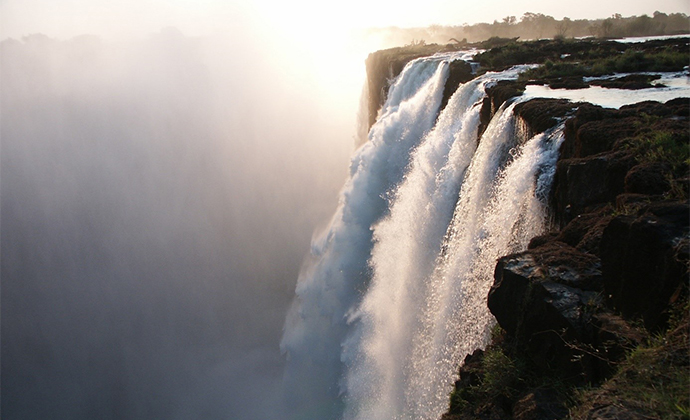
They have of course been helped by their location, which has allowed daytrippers to flock in from neighbouring countries, notably Zambia and Botswana, sampling a little of Zimbabwe’s treasures without actually staying here. Some tour groups cross the bridge from Zambia for better views of the falls without even realising they’ve entered Zimbabwe.
But if commercialisation has turned the place into something of a tout’s paradise, don’t let this put you off: this small, laid-back town (locals refer to it as ‘the village’) has somehow retained its charm and character. It has a casino or two and some glitzy hotels, but it’s certainly no Las Vegas. You’ll struggle to find a shop in the town centre that isn’t in some way related to tourism – apart from the supermarkets, you have to venture into the industrial area to source anything as mundane as hardware. Population estimates vary widely but it is currently in the region of 50,000. The continued economic success of this town at a time of rapidly deepening economic woes in the rest of the country seems to have led to a recent and ongoing influx of people hoping to join in the ‘boom’.
No introduction to the Falls would be complete without mentioning the original inhabitants – the animals. Warthogs dodge cars while rooting around in traffic islands and verges, with vervet monkeys always on the lookout for morsels left unattended on your plate or in your campsite. Baboons patrol the town, nonchalantly sharing the pavement with you, especially along the road to the Victoria Falls Hotel; but hang on to your bag of fruit and never be tempted to feed them. Elephants refuse to respect the presence of houses on their traditional trails, and view gardens, swimming pools and vegetable patches as fair game, lazily pushing down concrete walls in the process. They’ve been known to wander through town checking out the vehicles in the supermarket car park, while the cricket club reluctantly built a wall to stop elephants strolling across the wicket in mid-innings. So don’t for one moment treat these animals as if they are Jungle Book characters. There are usually at least two human fatalities per year down to elephants raiding the high-density suburbs, while close encounters with leopard and buffalo downtown are still fairly common at night-time.
Related books
For more information, see our guide to Zimbabwe:
Related articles
From boiling lakes to vast alpine bodies of water, these are our favourite lakes from around the world.
How many have you visited?
Sit back and enjoy this kaleidoscope of colours.
We’ve scoured the African continent for the best sites to spot rhinos in the wild.
Although tourism in Zimbabwe is a shadow of its former self, you should still make the time to visit
Make your trip to Zimbabwe even more special with some of these lesser-known destinations
Africa has some magnificent centuries-old rock art — how many have you visited?
